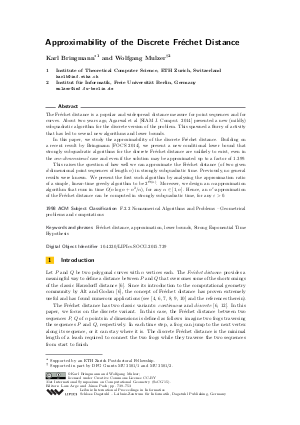Approximability of the Discrete Fréchet Distance
Authors Karl Bringmann, Wolfgang Mulzer
-
Part of:
Volume:
31st International Symposium on Computational Geometry (SoCG 2015)
Part of: Series: Leibniz International Proceedings in Informatics (LIPIcs)
Part of: Conference: Symposium on Computational Geometry (SoCG) - License:
 Creative Commons Attribution 3.0 Unported license
Creative Commons Attribution 3.0 Unported license
- Publication Date: 2015-06-12
File

PDF
LIPIcs.SOCG.2015.739.pdf
- Filesize: 0.53 MB
- 15 pages
Document Identifiers
Subject Classification
Keywords
- Fréchet distance
- approximation
- lower bounds
- Strong Exponential Time Hypothesis
Metrics
- Access Statistics
-
Total Accesses (updated on a weekly basis)
0PDF Downloads0Metadata Views
Abstract
The Fréchet distance is a popular and widespread distance measure for point sequences and for curves. About two years ago, Agarwal et al [SIAM J. Comput. 2014] presented a new (mildly) subquadratic algorithm for the discrete version of the problem. This spawned a flurry of activity that has led to several new algorithms and lower bounds. In this paper, we study the approximability of the discrete Fréchet distance. Building on a recent result by Bringmann [FOCS 2014], we present a new conditional lower bound that strongly subquadratic algorithms for the discrete Fréchet distance are unlikely to exist, even in the one-dimensional case and even if the solution may be approximated up to a factor of 1.399. This raises the question of how well we can approximate the Fréchet distance (of two given d-dimensional point sequences of length n) in strongly subquadratic time. Previously, no general results were known. We present the first such algorithm by analysing the approximation ratio of a simple, linear-time greedy algorithm to be 2^Theta(n). Moreover, we design an alpha-approximation algorithm that runs in time O(n log n + n^2 / alpha), for any alpha in [1, n]. Hence, an n^epsilon-approximation of the Fréchet distance can be computed in strongly subquadratic time, for any epsilon > 0.
Cite As Get BibTex
Karl Bringmann and Wolfgang Mulzer. Approximability of the Discrete Fréchet Distance. In 31st International Symposium on Computational Geometry (SoCG 2015). Leibniz International Proceedings in Informatics (LIPIcs), Volume 34, pp. 739-753, Schloss Dagstuhl – Leibniz-Zentrum für Informatik (2015)
https://doi.org/10.4230/LIPIcs.SOCG.2015.739
BibTex
@InProceedings{bringmann_et_al:LIPIcs.SOCG.2015.739,
author = {Bringmann, Karl and Mulzer, Wolfgang},
title = {{Approximability of the Discrete Fr\'{e}chet Distance}},
booktitle = {31st International Symposium on Computational Geometry (SoCG 2015)},
pages = {739--753},
series = {Leibniz International Proceedings in Informatics (LIPIcs)},
ISBN = {978-3-939897-83-5},
ISSN = {1868-8969},
year = {2015},
volume = {34},
editor = {Arge, Lars and Pach, J\'{a}nos},
publisher = {Schloss Dagstuhl -- Leibniz-Zentrum f{\"u}r Informatik},
address = {Dagstuhl, Germany},
URL = {https://drops.dagstuhl.de/entities/document/10.4230/LIPIcs.SOCG.2015.739},
URN = {urn:nbn:de:0030-drops-51072},
doi = {10.4230/LIPIcs.SOCG.2015.739},
annote = {Keywords: Fr\'{e}chet distance, approximation, lower bounds, Strong Exponential Time Hypothesis}
}
Author Details
References
-
Amir Abboud and Virginia Vassilevska Williams. Popular conjectures imply strong lower bounds for dynamic problems. In Proc. 55th Annu. IEEE Sympos. Found. Comput. Sci. (FOCS), pages 434-443, 2014.

-
Amir Abboud, Virginia Vassilevska Williams, and Oren Weimann. Consequences of faster alignment of sequences. In Proc. 41st Internat. Colloq. Automata Lang. Program. (ICALP), volume 8572 of LNCS, pages 39-51, 2014.

-
Amir Abboud, Ryan Williams, and Huacheng Yu. More applications of the polynomial method to algorithm design. In Proc. 26th Annu. ACM-SIAM Sympos. Discrete Algorithms (SODA), pages 218-230, 2015.

-
Pankaj K. Agarwal, Rinat Ben Avraham, Haim Kaplan, and Micha Sharir. Computing the discrete Fréchet distance in subquadratic time. SIAM J. Comput., 43(2):429-449, 2014.

-
Helmut Alt. Personal communication. 2012.

-
Helmut Alt and Michael Godau. Computing the Fréchet distance between two polygonal curves. Internat. J. Comput. Geom. Appl., 5(1-2):78-99, 1995.

-
Karl Bringmann. Why walking the dog takes time: Fréchet distance has no strongly subquadratic algorithms unless SETH fails. In Proc. 55th Annu. IEEE Sympos. Found. Comput. Sci. (FOCS), pages 661-670, 2014.

-
Karl Bringmann and Marvin Künnemann. Improved approximation for Fréchet distance on c-packed curves matching conditional lower bounds. arXiv:1408.1340, 2014.

-
Kevin Buchin, Maike Buchin, Wouter Meulemans, and Wolfgang Mulzer. Four soviets walk the dog - with an application to Alt’s conjecture. In Proc. 25th Annu. ACM-SIAM Sympos. Discrete Algorithms (SODA), pages 1399-1413, 2014.

-
Kevin Buchin, Maike Buchin, Rolf van Leusden, Wouter Meulemans, and Wolfgang Mulzer. Computing the Fréchet distance with a retractable leash. In Proc. 21st Annu. European Sympos. Algorithms (ESA), pages 241-252, 2013.

-
Paul B. Callahan and S. Rao Kosaraju. A decomposition of multidimensional point sets with applications to k-nearest-neighbors and n-body potential fields. J. ACM, 42(1):67-90, 1995.

-
Thomas Eiter and Heikki Mannila. Computing Discrete Fréchet Distance. Technical Report CD-TR 94/64, Christian Doppler Laboratory, 1994.

-
Anka Gajentaan and Mark H. Overmars. On a class of O(n²) problems in computational geometry. Comput. Geom. Theory Appl., 5(3):165-185, 1995.

-
Michael R. Garey and David S. Johnson. Computers and intractability. A guide to the theory of NP-completeness. W. H. Freeman, 1979.

-
Allan Grønlund and Seth Pettie. Threesomes, degenerates, and love triangles. In Proc. 55th Annu. IEEE Sympos. Found. Comput. Sci. (FOCS), pages 621-630, 2014.

-
Russell Impagliazzo and Ramamohan Paturi. On the complexity of k-SAT. J. Comput. System Sci., 62(2):367-375, 2001.

-
Russell Impagliazzo, Ramamohan Paturi, and Francis Zane. Which problems have strongly exponential complexity. J. Comput. System Sci., 63(4):512-530, 2001.

-
Mihai Pătraşcu and Ryan Williams. On the possibility of faster SAT algorithms. In Proc. 21st Annu. ACM-SIAM Sympos. Discrete Algorithms (SODA), pages 1065-1075, 2010.

-
Ramamohan Paturi, Pavel Pudlák, Michael E. Saks, and Francis Zane. An improved exponential-time algorithm for k-sat. J. ACM, 52(3):337-364, 2005.

-
Liam Roditty and Virginia Vassilevska Williams. Fast approximation algorithms for the diameter and radius of sparse graphs. In Proc. 45th Annu. ACM Sympos. Theory Comput. (STOC), pages 515-524, 2013.

-
Ryan Williams. A new algorithm for optimal 2-constraint satisfaction and its implications. Theoret. Comput. Sci., 348(2):357-365, 2005.

